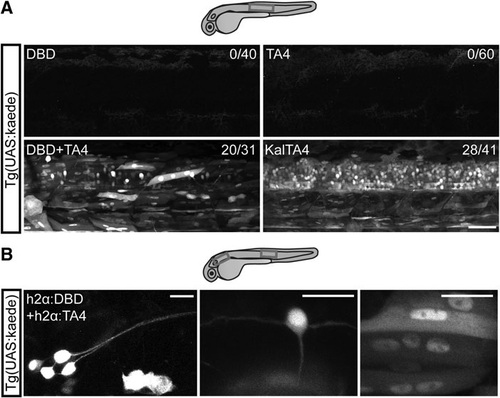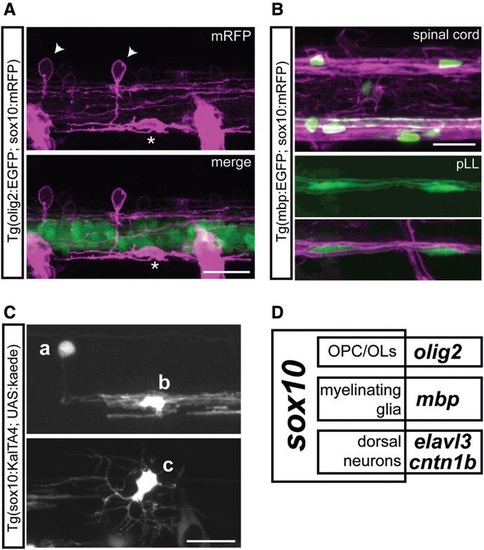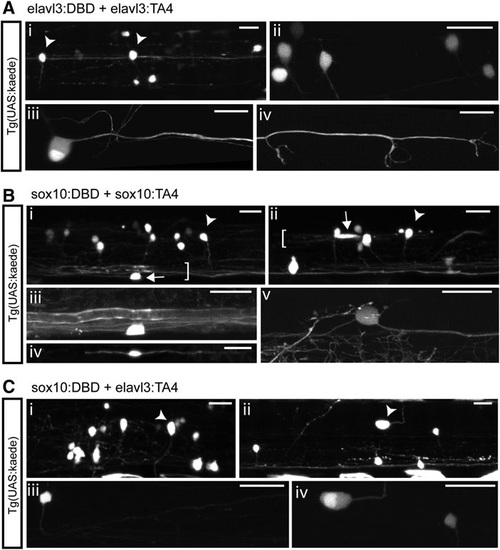- Title
-
Intersectional Gene Expression in Zebrafish Using the Split KalTA4 System
- Authors
- Almeida, R.G., Lyons, D.A.
- Source
- Full text @ Zebrafish
|
Split KalTA4 hemidrivers reconstitute functional KalTA4 in several cell types. (A) Lateral view of the trunk region of 2 dpf Tg(UAS:kaede) larvae injected with split KalTA4 hemidriver mRNA or control KalTA4 mRNA. Either DBD or TA4 mRNA alone does not activate kaede expression. DBD and TA4 mRNA in combination, or intact KalTA4 mRNA, is sufficient to activate the reporter UAS:kaede. Since heterozygous parent UAS:- kaede fish were outcrossed, the subset of nonfluorescent embryos are likely nontransgenic offspring. Numbers on top right indicate number of kaede+ embryos/number of total embryos. Boxes indicate approximate imaged regions. Scale bar: 50 µm. (B) Lateral view of the pLL ganglion (left) or trunk region (middle and right) of 2 dpf Tg(UAS:kaede) larvae injected with h2α:DBD and h2α:TA4. h2α-driven split KalTA4 expression results in activation of the reporter UAS:kaede in a variety of cell types, including peripheral neurons in the pLL ganglion (left), central neurons in the spinal cord such as a commissural primary ascending interneuron (middle) and muscle cells (right). Boxes indicate areas of imaged cells. Scale bars: 20 µm. pLL, posterior lateral line. |
|
Reporter transgenes indicate expression of sox10 in several cell types. (A) Lateral view of the spinal cord of 2 dpf Tg(olig2: EGFP; sox10:mRFP) larva. Arrowheads: examples of sox10:mRFP+ dorsal neurons; asterisk: example of olig2:GFP+ sox10:mRFP+ OPC. (B) Lateral view of the spinal cord (top) and pLL (bottom) of 4 dpf Tg(mbp:EGFP; sox10:mRFP) larva. Many OPCs become mbp:EGFP+ mature OLs by 4 dpf in the spinal cord, and are associated with sox10:mRFP myelin sheaths, as are mbp:EGFP+ Schwann cells in the pLL. (C) Lateral view of the spinal cord of 3 dpf Tg(sox10:KalTA4; UAS:kaede) larva. Cell a: dorsal neuron; cell b: OL; cell c: OPC. (D) Venn Diagram of the expression patterns of sox10, olig2, mbp, elavl3, and cntn1b, indicating some of the cell types found in the intersection of each subdomain. All scale bars: 20 µm. OL, oligodendrocyte; OPC, oligodendrocyte precursor cell. |
|
Split KalTA4 system restricts sox10 expression pattern to each component cell type. (A) Coinjection of elavl3:DBD and elavl3:TA4 activate reporter expression in neurons. (i) Overview of two spinal cord segments showing kaede+ neurons (arrowheads indicate examples of neuron somas). (ii) High-resolution view of spinal interneurons. (iii–iv) A pLL neuron and its axon innervating neuromasts. (B) Coinjection of sox10:DBD and sox10:TA4 activate reporter expression in neurons and glia. (i, ii) Spinal cord overviews showing kaede+ neurons (arrowheads) and OLs (arrows) forming myelin sheaths (brackets). (iii) High-resolution view of ventral OL in (i). (iv) A Schwann cell in the pLL. (v) High-resolution view of a Rohon-Beard cell in the dorsal spinal cord. (C) Coinjection of sox10:DBD and elavl3:TA4 activate reporter expression only in neurons. (i, ii) Spinal cord overviews showing kaede+ neurons (arrowheads). (iii) High-resolution view of a circumferential descending interneuron. (iv) High-resolution view of Rohon-Beard neuron and of a dorsal interneuron in (ii). All panels are lateral views at 4 dpf; all scale bars: 20 µm. |



